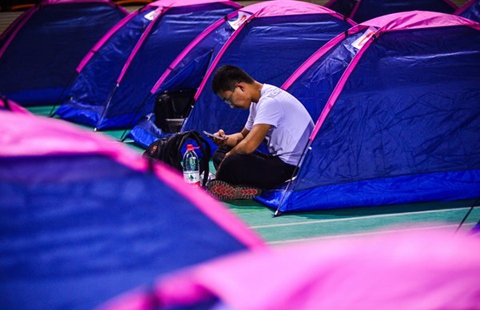
Traveling from Dar es Salaam to Livingstone by train is a tiring, exhilarating 2,400 km journey that uses two of Africa's greatest railway systems
Thousands come to Africa on safari, but few think to do it the way I did a decade ago, albeit unexpectedly.
I was heading for Livingstone, in the southern province of Zambia, from Dar es Salaam, the east coast city of Tanzania.
That's a mighty journey, covering approximately 2,400 kilometers using two of Africa's greatest railway systems.
The first part would carry me from Dar es Salaam - the country's largest and richest city, and a regionally important economic center - to Kapiri Mposhi, a small town in central Zambia, located north of the capital, Lusaka.
That's 1,860 km using the now-iconic Tanzania Zambia Railway Authority (or as everyone calls it, TAZARA), which was completed by the Chinese in the early 1970s; and 550 km on Zambia Railways, from Kapiri Mposhi to Livingstone, a line built by the British during colonial times. The two stations linking those two famous lines in the town are just 1 km apart.
I boarded the TAZARA around 4 pm, just as the sun was starting to set on Dar es Salaam.
After passing through immigration, I headed for my second-class sleeper and prepared for a long journey.
The TAZARA leg would be about 40 hours, and I needed something to keep me alert, so I pulled Robert Ludlum's The Bourne Identity from my bag to kill the time.
I fully expected to finish it by the time I disembarked at Kapiri Mposhi.
This was in 2004, when the coaches were comfortable and the service excellent, before the authority started to run into financial difficulties. It felt really comforting when the train eased rather lazily out of the station, trumpeting its departure quite majestically to Dar es Salaam's residents, as they made their way home through the packed streets outside.
After leaving the coast, we headed due west, then dipped south into Mikumi National Park, before entering the Selous Game Reserve. The two form a unique ecosystem, and I was in for a treat. The landscape of Mikumi is often compared to that of Tanzania's more famous Serengeti National Park, the UNESCO World Heritage Site.
The Mikumi belongs to the circuit of the wildlife parks of Tanzania, which were then visited less by international tourists and were better protected environmentally.
But there I was, relaxed in my seat, watching giraffe, elephant, zebra, antelope and warthogs, outside my window. The animals also were preparing to retire after a long day, and it became increasingly dark as we continued through Selous. I had dozed off by the time the train crossed the 300-mile Great Ruaha River.
Further south, the railway cut through the fertile Kilombero Valley, a unique, complex ecosystem with one of the highest wild mammal densities in Tanzania, and it then skirted the great Kibasira Swamp, which extends over 100 km east to west and is the source of the Kilombero river, which flows through a network of gorges to join the Rufiji river inside the adjacent Selous reserve.
My train guard was my guide. Despite the amazing scenes so far, he told me the really interesting parts of the journey came between Mlimba, the "Kingdom of Elephants", and Makambako, the "Place of Bulls", covering roughly 160 km. "Perhaps", he said, "the most spectacular feature is the bridge across Mpanga River valley, which stands 50 meters above the river on three pillars."
This journey didn't pass it, but I did on my way home, and it was indeed spectacular.
By sunrise, we were climbing into the southern highlands of the Iringa Region, which now has many established industries, including manufacturing and food processing.
Its capital of the same name is now a minor transport hub, with regular bus services and trucking to Dar es Salaam.
The train leveled out onto a rolling plateau of coffee and tea plantations. It passed the town of Makambako, and then entered Udzungwa Mountains National Park, which rises 2,000 meters above sea level.
We passed through what seemed like endless tunnels - there are in fact 20.
From Makambako, the railway and the highway run parallel toward the large town of Mbeya, which sprawls through a narrow highland valley surrounded by a bowl of high mountains, and which was founded at the turn of the century as a gold mining town.
Today it is considered the country's largest producer of maize, rice, bananas, beans, potatoes, soya and wheat.
From Mbeya, the railway and the highway then headed northwest for 112 km to Tunduma, before crossing the Tanzania-Zambia border at Nakonde. I knew we were in Zambia when the train was boarded by money changers, offering Zambian kwacha and even dollars for my Tanzanian shillings.
The border officers, to save time and hassle, checked our passports while the train was still moving. The Zambian countryside was lush bush, and it was fabulous and relaxing to see it from the comfort of my bed.
By this time I had almost finished my novel, and cursed myself for not bringing more.
After entering the country's Central Province, the track again turned to the southwest, running along the northern foothills of the Muchinga Mountains, which serve as a divide between the drainage basins of the mighty Zambezi (Indian Ocean) and the Congo (Atlantic Ocean) rivers, and past the towns of Serenje and Mkushi.
I remember we arrived in Kapiri Mposhi at around 10:30 am. I crossed the road and walked to the Zambia Railway station, where I bought a ticket to Livingstone. But it was more crowded than normal because Nelson Mandela was making his first visit to Lusaka the next morning, since his release from prison.
We finally arrived in Lusaka probably around the same time as Mandela - there had been delays. I was tired, not helped by the ageing train and the tracks that carried it.
I could see people on the streets outside preparing to greet the greatest freedom fighter in history, and I wished I was part of the crowd. But I had a journey to complete.
My train then trundled south to Livingstone, and finally I arrived, desperately looking forward to a hot bath and bed. I was dirty and smelly after traveling almost 60 hours without a decent wash.
But the journey was worth it, and the memories linger to this day.
The author is a journalist with The Daily News in Tanzania.
(China Daily Africa Weekly 09/05/2014 page9)








